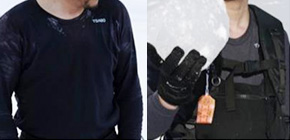
Vital data collected from arctic expeditionary team members in smart clothes
A group of researchers from Osaka University and TOABO Corporation produced a new “smart clothing” made of merino wool, which provides effective protection against the wind and weather in extreme cold conditions, collecting vital signals such as heart rate from the members of an arctic expedition team wearing the smart clothes during the expedition.
Explorer OGITA Yasunaga, together with 12 young people and a photographer, completed a distance of 600 km from Pangnirtung to Clyde River in the Canadian Arctic during the “Arctic Circle Adventure Walk 2019” conducted from April 7, 2019 through May 5, 2019. During their expedition, the team members kept the smart clothes on without changing, allowing for continuous measurements of vital signals in extremely cold weather.
In extremely cold environments, choice of underwear is a matter of life and death. When underwear absorbs sweat during activity in extremely cold weather, the cold air freezes the water, rapidly drawing heat from the body and causing hypothermia.
Because the expedition members would not change underwear during their one month expedition, a group of researchers from Osaka University and TOABO came together to jointly develop new smart clothes.
The smart underwear must:
- Prevent the loss of latent heat through the evaporation of sweat from the skin surface and keep the body warm in extremely cold weather.
- Withstand long-term use and have deodorizing effects.
- Allow for the installation of dry electrodes for heart rate measurements during the expedition without bringing a sense of discomfort to the skin.
They used merino wool, a natural renewable fiber, and a stretchable conductive film COCOMI® by TOYOBO as electrodes for measuring heart rate (instead of disposable electrodes generally used for ECG measurement, which tend to cause skin irritation). TOYOBO installed the electrodes, finishing the underwear for biological data collection.
A wearable heart rate sensor myBeat (WHS-1) made by Union Tool Co. was used for collecting vital data. Union Tool Co. enhanced its waterproof property, providing a silicon jacket for protecting it from water droplets such as sweat.
Ogita and 10 of the young people wore the finished underwear for collecting vital data. The underwear was warm and comfortable and neither released a nasty smell nor caused a rash on the skin. Of the 23 heart rate meters, vital data was collected using 17 of the meters that worked properly. The data showed that the heart rate of the expedition members changed gradually and an excessive increase of heart rate was suppressed within 5 days from the beginning of the expedition.
Smart clothes in natural materials such as wool have not yet been developed. The use of natural materials has a functional advantage and can contribute to the achievement of Sustainable Development Goals (SDGs), which aims to significantly reduce microplastics. Moving forward, these smart clothes will be used to help people safely enjoy adventures and mountain climbing trips through the understanding of how the body adapts to such a cold environment.
Figure 1
Photo of the Arctic Circle Adventure Walk 2019 (From left): OGURA Hidefumi, OGITA Yasunaga, and MIURA Yoshitaka
(Credit: Ogita Expedition Office)
Related links
